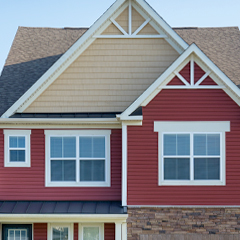Understanding Why Vinyl Siding Wins Big for Home Builders, Remodelers and Consumers
The vinyl siding industry has grown favorably in recent years, maintaining strong market share in key segments of the U.S. and Canada, thanks to its affordability, durability and design benefits, as well as launches of new colors, styles and other product innovations by its leading manufacturers.
Yet the industry still contends with myths circulating for years by competitors who try to dismiss vinyl siding as cheap. To combat this misinformation, the Vinyl Siding Institute (VSI) developed a “Facts & Science” approach to educate key stakeholders on polymeric sidings’ multitude of benefits – for home builders, consumers and the environment.
Here's how VSI’s Facts & Science stand up to 5 of the most common myths about vinyl siding:

Myth #1: Vinyl siding reduces the value of your home.
FACT: Vinyl siding actually increases your home’s value. A 2022 Home Remodeling Impact Report – published by the NAR (National Association of Realtors) in cooperation with the NARI (National Association of the Remodeling Industry) holds that a vinyl siding upgrade will raise your home’s value by 82% of the project’s cost. This is an increase of almost 20% from the 2019 Home Remodeling Impact Report, which strongly suggests that there has been greater market awareness of vinyl siding’s overall benefits and product improvements in recent years.
Therefore, by adding a fresh appearance to your exterior with a durable, low maintenance and energy-efficient cladding, vinyl siding increases your home’s value.
Myth #2: Vinyl Siding warps and buckles.
FACT: Vinyl siding expands and contracts as the weather outside changes. In the summer, when temperatures skyrocket, vinyl siding expands. Issues like warping and buckling only occur when siding is not installed properly. Fortunately, there is a growing number of experienced, certified vinyl siding installers near you (thanks to VSI’s Workforce Development Program) who help ensure that your home’s vinyl siding looks terrific and performs well for years to come.
Myth #3: Vinyl Siding melts.
FACT: Vinyl siding only has the potential for melting when exposed to concentrated sunlight reflecting from energy-efficient (a.k.a “low-e”) windows, which is not very common. The “melting vinyl siding” tactic is perhaps the most popular negative marketing approach used by competitors – and the internet is filled with these false claims. Interestingly, multiple competitors use the same bogus melted vinyl siding image to prove their point. The truth is that other exteriors and materials, including cedar shingles and painted surfaces, are also impacted by this phenomenon. This issue is related to window design and can easily be prevented by using sunshades above low-e windows or a variety of landscaping options to block the path of sunlight.
Myth #4: Vinyl siding is difficult to recycle.
FACT: Vinyl siding may be the most recyclable material in the home building industry. Research from the Vinyl Institute reports that 1+ billion pounds of vinyl/PVC is recycled annually in North America, and most of the recycled vinyl comes from pre-consumer recycling. Vinyl siding recycling starts at the beginning of its lifecycle – the manufacturing. VSI member manufacturers invented and continuously perfected the co-extrusion process so there is less than 1% waste. All materials on the “cutting room floor” are recycled to make more vinyl siding. As for the aftermarket, 99% of vinyl siding scrap can be returned to the manufacturing process – and not just for VSI member manufacturers. Other PVC manufacturers recycle the vinyl siding scrap to make decks, patio furniture, vinyl windows and more.
The same report found that post-consumer vinyl recycling has increased by 40% since 2014. In 2021, VSI members and key stakeholders launched the Northeast Ohio Vinyl Siding Recycling Coalition.
VSI and its industry partners have made a significant investment in developing an aftermarket recycling model that may be replicated throughout North American, depending on result of the pilot program. In the meantime, a phone call to your local distributor or proactive recycling firm (there are over 100 in North America) will result in collection of vinyl siding scrap that will go back to a proactive manufacturer to make new products.
Myth #5: Vinyl siding is not eco-friendly.
FACT: Vinyl siding’s lifecycle impact on global warming is significantly lower than other cladding products. That includes 79% less impact than fiber cement and 85% less impact than brick and mortar (based on analysis using Building for Environment and Economic Sustainability [BEES] software). All VSI member manufacturers’ products are the only exterior options that are both UL-Certified and have Environmental Product Declarations (EPDs), providing builders with authentic data on their environmental benefits.
Because of the industry’s strong commitment to improving the sustainability of its products over the last 20 years, vinyl siding products are well-qualified for points in green rating systems from all the major code councils and NGO trade authorities that have emphasized greener building products and best practices in recent years. In fact, the vinyl siding sector leads all other cladding producers in driving their sustainability agenda forward. This includes a consultative partnership with Sustainable Solutions Corporation to evaluate progress and continuously improve their carbon footprint for the benefit of society.
To learn more truths about vinyl siding, visit www.vinylsiding.org.
_____________________________________________________________________________________________________________________________________________
Don Browne is a writer, entrepreneur and local legislator who believes that the power of words can change the world. He provides unique writing services for clients in the construction, health care, IT and hospitality sectors. He has a passion for small business and start-ups, as well as writing about Irish history, family and corporate biographies. As a homeowner and father of four who is passionate about community development, Don looks forward to writing more about the exciting possibilities of creating traditional neighborhoods and more sustainable communities using modern materials.